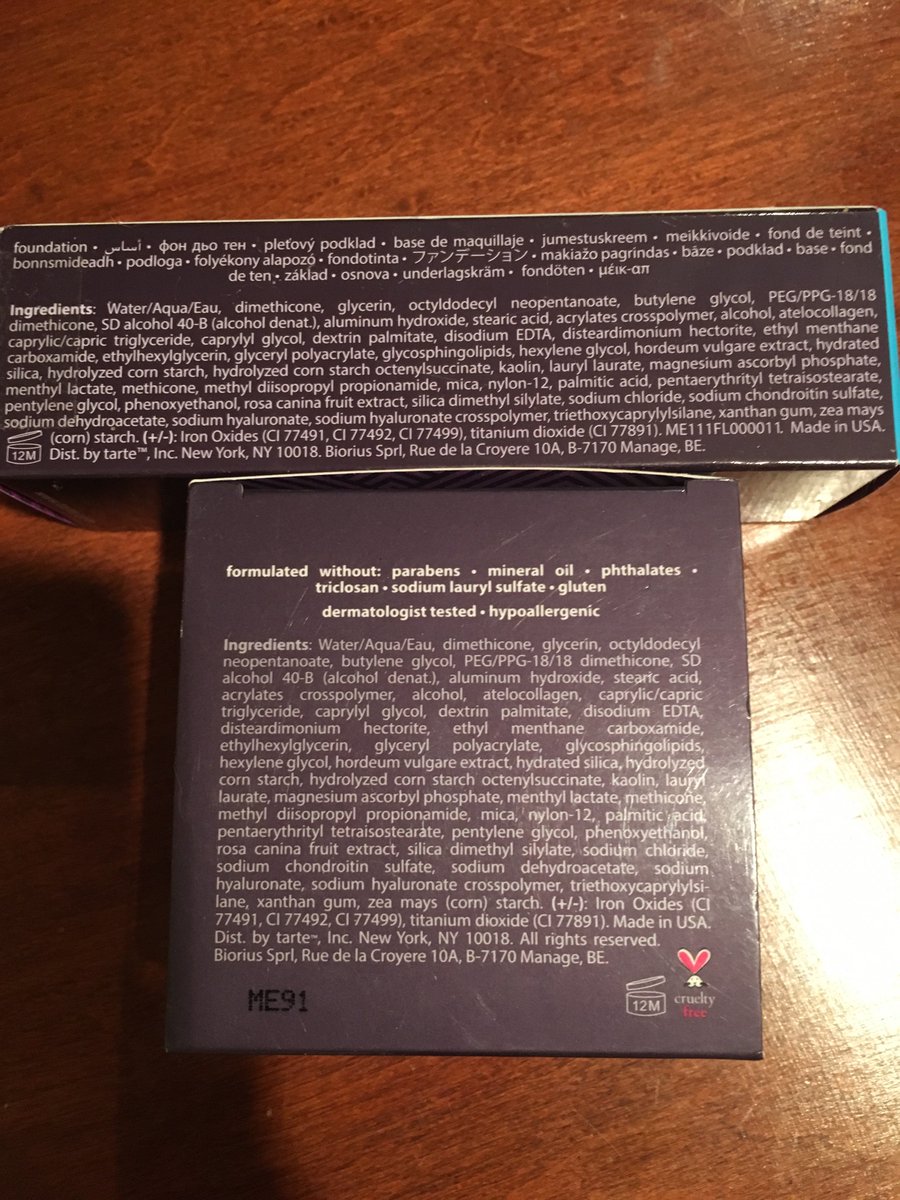 Tarte Shape Tape Hydrating Foundation: Probably the hottest anticipated foundation launch so far this year, but pity the shade range
Tarte Shape Tape Hydrating Foundation: Probably the hottest anticipated foundation launch so far this year, but pity the shade rangeWhat today's blogpost will focus on is another issue with the Shape Tape Foundation, specifically the Shape Tape Hydrating Foundation. What's the source of the controversy with the Shape Tape Hydrating Foundation? Basically that Tarte was already re-releasing an existing formulation as a new product. The existing product in question? Tarte's Hybrid Gel Foundation, which has already been on the market for awhile. So, if this is indeed true, it means that all Tarte did was essentially repackage their existing product into a different container, and then tried to sell it as a different product. And that, of course, would be awful.

Tarte Shape Tape Hydrating Foundation is also claimed to be identical to the existing Hybrid Gel Foundation
So, in today's post, let's see how this little kerfuffle started, and take a look and see how similar the two products are, and whether they are really dupes or not!
So, how did this entire incident start? It started when very observant Twitter user KilesSmiles noticed that the the ingredients lists of both the Shape Tape Hydrating Foundation and Hybrid Gel Foundation were exactly the same, and tweeted to superstar uberfamous blogger Temptalia:
@temptalia same foundation?!? (Tarte hybrid gel and hydrating shape tape) pic.twitter.com/c28MzN5Mex
— Kiley Conroy (@KilesSmiles) January 20, 2018
And then Temptalia concurred, and went to compare her own ingredients list, and also found that they were the same:
This is really strange! I put the ingredient lists in Excel for both (from Tarte's site), & they seem to match 1-for-1, including order... https://t.co/hDN65IfLDy. Reader has both physical boxes & says they feel the same. What's going on?!? 🤔 https://t.co/MoeRkwk6pC
— Temptalia (@temptalia) January 20, 2018
And, after that, Tarte responded on Twitter, that although the formula was the same, the "proprietary manufactring method" was the same, which gave the Shape Tape Foundation a "different texture, application and finish".
Yes, they have the same ingredients. We used our most hydrating formula as a base but mixed, filled and cured it through the proprietary manufacturing method we created for shape tape concealer. This process gives it a different texture, application and finish.
— tartecosmetics (@tartecosmetics) January 20, 2018
After that, there wasn't much ado about it, but unsurprisingly, some people felt that the explanation wasn't convincing, as you can imagine from these couple of tweets below:
Their excuse is bullshit. I'm a cosmetic chemist, and surely if it was a new formula, they'd have changed it, even just slightly! Technology advances so quickly you have to try to improve it.
— J-M (@Janne_Marii) January 20, 2018
Sorry @tartecosmetics but I’m not buying this explanation at all, it just doesn’t make sense to me. The texture and application are the same, so where is the difference? You know the saying if it walks like a duck and it quacks like a duck? Well I see a big ol’ duck
— Yodelin Joda (@yodelinjoda) January 20, 2018
Of course, it didn't help that the two actual products also seemed pretty similar!
I have both and they look and feel the same. I’m the one who tweeted @temptalia pic.twitter.com/aOQu1FHiO9
— Kiley Conroy (@KilesSmiles) January 20, 2018
So what are we to make of this? Are the ingredients list really the same? And is it possible for two products to have the same ingredients list and yet be meaningfully different? For the first question, the answer is easily verified by looking at the actual photos of the ingredients list (courtesy of KilesSmiles of course!):

Tarte Shape Tape Hydrating Foundation and Tarte Hybrid Gel Foundation ingredients lists: Definitely a whole lot of similarities!
From the photo above, it's clear to see that the ingredients lists are indeed identical. Both the Shape Tape Foundation and the Hybrid Gel Foundation do use the same sort of emollients (dimethicone, octyldodecyl neopentanoate, PEG/PPG-18/18 dimethicone, stearic acid), and humectants (glycerin, butylene glycol) and so on. And both also contain some amount of alcohol, too (which seems a little odd in a "hydrating" foundation, but I assume it's probably there in very low amounts). And yes, basically the ingredients list is identical from top to bottom. So going by the ingredients list, the Tarte Shape Tape Foundation and Hybrid Gel Foundation are indeed dupes for each other!
So with that out of the way, I want to look closer at whether the "manufacturing process" can really influence the product's texture/finish/etc. as claimed by Tarte. Although I'll admit to being skeptical, especially in light of all the Tweets from people who have both saying that they felt and looked the same, I wondered if it was possible for two products with identical ingredients to somehow come out different?
For this, I sought the help of Colin, who is a cosmetic chemist, and also has the blog Colin's Beauty Pages (also one of my favourite reads), and asked if he could explain whether it is possible that two products with identical product ingredients lists could still somehow be different. His initial response was that it was "Well it's not likely, but it is possible."
Well it's not likely, but it is possible.
— beautyscientist (@beautyscientist) January 26, 2018
That piqued my interest, and I wanted to know, how exactly would it be possible? So I basically pestered Colin, and he was kind enough to give the following explanation:
Ingredient lists are flexible enough that it does happen from time to time that two different formulations end up with the same list. It is also possible to make very different products from the same ingredients by the way you process them. There's a very familiar example to anyone who does a lot of cooking. Chemically speaking granulated sugar that you put in your tea or coffee is identical to icing sugar that you use to make cakes. One simply has a much smaller particle size than the other. In cosmetics the difference between normal titanium dioxide and nano titanium dioxide is even more spectacular. Normal titanium dioxide is white and has a fairly low SPF. The nano form gives the skin a ghostly blueish appearance and can achieve very high SPF levels indeed.
So it is certainly possible that the particle size of the pigments in a foundation might have a big effect on the colour of the product once it is applied to the skin. Having said that, it isn't how I personally would go about formulating a foundation. It would be much more convenient for the factory to have a single way of processing their products. So I find the suggestion that the Tarte Foundation is made using the same ingredients just treated differently rather surprising. But it isn't totally impossible.
So there you go! Is it possible that two products could have the same ingredients lists and somehow still be different? Yes, possible, but not likely. What's interesting here is that Colin's explanations mostly focused on the differences between grades of ingredients that have the same name on ingredients lists (e.g. particle size of ingredients like titanium dioxide and pigments), although he does agree that the process could influence the outcome too. However, Tarte's response seems to only address the manufacturing process part, and doesn't indicate that any of the ingredients were actually different. And to me, that's kind of unconvincing - for all I know, the only "difference" in the manufacturing process could have been during the filling and bottling stage - when you put one product into pump bottles and another into jars! Technically that would still qualify as a different manufacturing process, even if only right at the final stage! So I feel like Tarte's response, while commendable for its timeliness and actual ability to offer more information, still left something to be desired. I guess it just didn't answer all the burning geeky nerdy questions I had, which to be fair may be hard to answer in full.

Tarte Shape Tape Hydrating Foundation: More likely than not a dupe for the Hybrid Gel Foundation, or if not, very very similar!
But after all that's said and done: Are the Tarte Hydrating Foundation and Hybrid Gel Foundation actually dupes? It's hard to confirm, since we don't have any more information behind a rather PR-ish tweet, but it's quite likely that they are (or at least, more likely than not). This is especially given the feedback on Twitter about how they seem similar when applied, too. So if you've been curious about the Tarte Shape Tape Foundation and have tried the Hybrid Gel Foundation before, chances are, even if they aren't dupes for each other (which doesn't seem too likely), they'll be pretty similar, and you'll have a good sense of how one works based on your experience with the other.













I just wanted to add, while I agree that the manufacturing process can make changes if it varies (think of baking a cake, if you cream the butter and sugar together you get a different result than if you do not), odds are that any differences are imperceptible to the average user.
ReplyDelete@Jayme: Yes that's a really good point too! Unfortunately this sort of thing happens a lot with beauty products. A lot of times claims like "gives your hair 20% less breakage!" may be verifiable in the lab but not often perceptible to the average consumer when the product is used. Such claims aren't actually a lie but just that consumers may not feel the difference, sadly!
ReplyDeleteGreat post! Here's another angle for you. I am a graphic designer for a chemical company's labels and packaging. If our Safety Data sheet has an ingredient that is a trace amount, less than 1%, we don't have to list it in the ingredients on the label. Maybe that could be the difference between the two foundations, an unlisted ingredient?
ReplyDelete